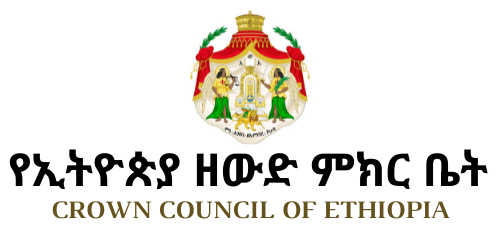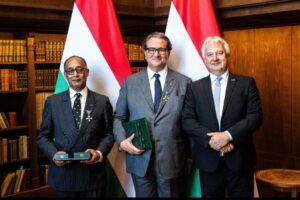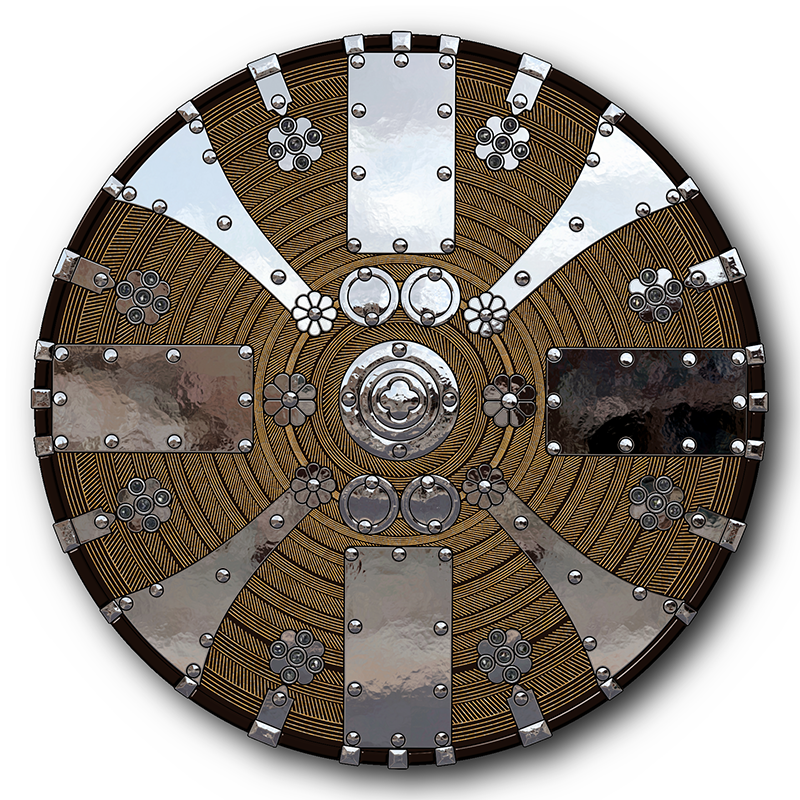The United States Library of Congress – Hebraic Section
Presented by His Imperial Highness Prince Ermias Sahle-Selassie Haile-Selassie, President of the Crown Council of Ethiopia,
Good afternoon friends, scholars, and distinguished guests. It is my great honor and privilege to be with you today, here in the renowned Hebraic section of the United States Library of Congress, African and Middle Eastern division.
To begin, I will share with you an ancient Ethiopian saying…
“…We must study the past and understand the present to charter a better future for us all…”
I must tell you that I am not a theologian, and make no pretense at being so. Indeed, some, perhaps many of you, already possess extensive knowledge of today’s subject – the origins and religious symbolism of the Lion of Judah. Consequently, I will initially introduce the subject and hopefully end with a robust Q&A period, which I anticipate will prove enlightening and entertaining for us all…
It is with great reverence, humility and some concern that I come before you to discuss and explore our topic. My concern springs from the certain and harsh knowledge that wherever the poetry and magic of myth is interpreted as biography, history or science, it is frequently mortally wounded. The living images become only remote facts of a distant time or sky, and it is never difficult to demonstratethat as science and history, mythology is in large part absurd. Thus, when a civilization begins to reinterpret its mythology in this way – as biography, history or science – the life goes out of it, temples become museums or tourist attractions, and the link between the two perspectives is dissolved. In modern times, arguably, such blight has even descended on the Holy Bible and a great part of the Christian movement.
The late and renowned American mythologist, writer and lecturer, Joseph Campbell, has observed that symbols are simply the vehicles of communication; and that they must not be mistaken for the final term, the tenor, of their reference. Thus, no matter how attractive or impressive symbols may seem, they remain but convenient means accommodated to the understanding. Hence the personality or personalities of God — whether represented in Trinitarian, Dualistic, or Unitarian terms, pictorially or verbally, as documented fact or apocalyptic vision — no one should attempt to read or interpret as the final thing.
The abiding challenge of the theologian is to keep his symbol translucent, so that it may not block out the very light it is supposed to convey. “For then alone do we know God truly,” writes Saint Thomas Aquinas, “when we believe that He is far above all that man can possibly think of God.” Thus mistaking a symbolic vehicle for its tenor can lead to spilling not only of valueless ink, but of valuable blood as well.
To bring the images back to life, one must seek, not interesting applications to modern affairs, but illuminating hints from the inspired past. When these are found, vast areas of half-dead iconography disclose again their enduring and permanently human meaning…
THE JEWS:
In the Jewish tradition, the earliest reference to the Lion of Judah comes from Genesis which is the first book of both the Hebrew Bible (Torah) and the Christian Old Testament. The book of Genesis is generally conceded as having been written sometime between 1400 and 1440 B.C. In Genesis 49:9 when blessing his son Judah, the Jewish patriarch Jacob refers to Judah as a “Young Lion”. Thus here we first note the lion’s becoming metaphorically and symbolically paired with Judah and the Jews. It is also from this text that the Lion of Judah further evolves into a titular station or office – defender and leader of the Jewish Tribe, which itself subsequently becomes the basis of considerable messianic expectation and speculation in early Judaism. Indeed, King David the Jewish Messiah becomes inextricably and historically linked in the Judaic and Christian traditions as the reference for the Lion of Judah.
We frequently find lion gates in archaeological ruins, from Israel to the gates of Ethiopia’s Axumite empire’s palaces and temples to the Hittite sites in Turkey to the Babylonian and Persian sites in Iraq, or the Assyrian and Egyptian sites. It was a widespread and popular symbol of royalty, as the lion was seen by many as the king of the predators, or even the king of all beasts. In fact we know that Ramses II kept live lions, as did successive Ethiopian Emperors up until the time of my late grandfather, the last Christian Emperor, His Imperial Majesty Haile Selassie.
In ancient Jewish art, we often find lions depicted in a protective role, guarding the Ark of the Covenant or at chapel entrances, as in the sculpture of the ancient synagogues at Sardis (in Asia Minor), Horazin and Bar’am (in Palestine), and in many mosaics dating from the early Byzantine era (330ad – 700ad). In medieval Jewish art, the lion pair is commonly depicted leaning up on either side of the Tree of Life, next to the crown; thus is the heraldic shield replaced by a symbol of God, and the lions are seen as serving the King of all Kings.
In modern times the Jewish heraldic representation of the city of Jerusalem remains the venerable Lion of Judah.
THE CHRISTIANS:
In the subsequent Christian tradition the lion allegory persists in the New Testament Book of Revelations 5:5; “And one of the elders saith unto me, Weep not: behold, the Lion of the tribe of Judah, the Root of David, hath prevailed to open the book, and to open the seven seals thereof.” Although the dominant image of Jesus in Revelation is the slain, but now triumphant lamb, the Apostle John continues to employ the powerful and traditional lion symbol. Revelations 5:5 proclaims that the lion of the tribe of Judah has already triumphed, not through final judgment on the wicked, but rather through his atoning death which opens up the possibility for all to be saved. Christ, therefore, is worthy to unseal the judgment scroll because he has already achieved salvation through his death as the slain and sacrificed Lamb of God who takes away the world’s sin. Theologians generally concede that the symbol is read and understood as a direct reference to Jesus, where he is regarded as the ‘lion of the tribe’ and ‘Root of David’
In Christianity, the Lion of Judah symbol is commonly used to refer to Jesus Christ. In fact, many Christian ministries use the symbol as their emblem or a prefix to their names. The Bible further reveals other instances when Jesus was referred to as the Lion of Judah:
- Gen 49:8-9: The Lion of Judah, a strong fighter against the enemy.
- Hebrews 7: 14: It is evident that our Lord has risen out of Judah concerning which tribe Moses spoke nothing about priests.
Christians believe that while the ancient tribe of Levi prepared priests, that of Judah was the tribe of the Kings. Jesus is believed to be a descendant of the Tribe of Judah. Jesus is commonly referred to as the ‘overcoming one’ and ‘the one qualified to open the scrolls and seven seals’. According to the Book of Revelations 5:5, Jesus was the ‘sacrificial Lamb’ and the ‘Lion of Judah’. The prophecy of the coming of the Lord to ‘judge the world’ as the Lion of Judah is clear all through Revelations 5:1-5.
Is it then correct to portray Jesus as the lion of Judah? Yes, with the critical distinction that Christ’s triumph comes through his sacrificial death, not primarily through final judgment retribution. We must also remember that Revelation was written for a relatively young and evolving Christian sect under extreme social and political persecution that encouraged its adherents to follow the path of non-violent and sacrificial death, as did Jesus. This is arguably why Revelation’s most powerful image is Jesus the slain lamb, not Jesus the lion.
THE ETHIOPIANS AND THE KEBRA NAGAST:
As the Earth’s oldest independent nation, Ethiopia traces its unbroken history back more than 5 millennia. The earliest records of Ethiopia – around 3000 BC, just prior to the Egyptian Old Kingdom period (2650- 2134 BC), come from Egyptian traders who refer to lands south of Nubia (or Cush) as Punt and Yam. The first known Egyptian voyage to Punt occurred in the 25th century BC under the reign of Pharaoh Sahure. The most famous Egyptian expedition to Punt, however, comes during the reign of Queen Hatshepsut probably around 1495 BC, as the expedition was memorialized in intricately detailed carved reliefs on the temple of Deir el-Bahri at Thebes. The inscriptions depict a trading group bringing back myrrh trees, sacks of myrrh, elephant tusks, incense, gold, various fragmented woods and exotic animals. The Egyptians sometimes called Punt land Ta-Netjeru, meaning “Land of the Gods,” and considered it to be their place of origin. There are also numerous references to Ethiopia in the Old Testament of the Hebrew and Christian Bibles.
As the Old Testament is to the Hebrews or the Qur’an to Islam, The Kebra Nagast, the Book of the Glory of Kings of Ethiopia, is the ancient and revered repository of our country’s millennia-old national and religious history. More than 700 years old in its present written form, The Kebra Nagast derives from Ethiopia’s millennia-old oral tradition, and details the history and origin of the Solomonic line of Ethiopian Kings. It is also regarded to be the definitive authority on the history of the conversion of Ethiopia to Christianity.
The Solomonic Dynasty of Ethiopia is so named by virtue of dynastic decent from the union of the venerable Jewish Messiah, King Solomon of Israel, and Queen Makeda of Sabae (Sheba), more than 900 years BC. By Ethiopian dynastic tradition, all monarchs must trace their lineage back to Menelik I who was the offspring of King Solomon and the Queen of Sheba. In 1930, my grandfather, The Last Christian Emperor, took the name Haile Selassie, meaning “Power of the Trinity.” His full title of office was “His Imperial Majesty Haile Selassie I, King of Kings, Conquering Lion of the Tribe of Judah, and Elect of God”. These titles have been traditionally given to Ethiopian kings to recognize the Old Testament emphasis of Ethiopian Christianity and declare the regent’s sacred duty and subservience to God.
That is why frequently Ethiopian monarchs refer to the psalmists quote: “Princes shall come out of Egypt, and Ethiopia shall reach her hand unto God.”
In Ethiopian tradition, Menelik, who had returned as a young man to visit his father, Solomon, in Jerusalem, was regally received. When Menelik departed for Ethiopia, King Solomon, much pleased by the regal manner and demeanor of his royal offspring, ordered the chief priests and advisors of the kingdom to send their first-born sons with him for the benefit of the Ethiopian crown which Menelik was to inherit. Among these was the son of Zadok, the High Priest, who it is claimed, took the Ark of the Covenant with him. The theft was concealed from Menelik, who did not learn of it until the royal party had returned to Ethiopia. The symbolism of the Ark is particularly potent in the Ethiopian Orthodox Church. Every church in Ethiopia must contain a replica of the Ark before it can be consecrated. One of the most important festivals in the calendar of the Ethiopian Church is that of Timkat, during which the Ark (or a replica) is wrapped in a shroud and carried in a great procession.
The Kebra Nagast relates the marvelous story of how the Ark of the Covenant came to be in Ethiopia, where it is believed to be enshrined in a special treasury – The Chapel of the Tablet – constructed next to the Church of St. Mary of Zion in Axum. It is reported that the Ark was moved from St. Mary’s into the new Chapel of the Tablet because a divine ‘heat’ from the Tablets had cracked the stones of its previous sanctum. Indeed, my grandmother, Emperor Haile Selassie’s wife, Empress Menen, paid for the construction of the new chapel.
The church of St. Mary of Zion in Axum is a venerable icon of Ethiopian religious belief and legend. It is also the most important church in Ethiopia. St. Mary is dedicated to the Holy Mother Mary who in the Christian tradition was the “vessel” of Christ, and thus the fulfillment of religious prophecy. Adherents believe that when Mary was exiled in Egypt that she visited Ethiopia. The original St. Mary of Zion was built in the 4th century AD and has been destroyed and rebuilt at least twice. By Tradition, St. Mary of Zion is the holy place of investiture for all Ethiopian emperors.
Ethiopia was a respected and sophisticated kingdom in the time of the New Testament. In fact, the Ethiopian “eunuch” in the 8th chapter of the Acts of the Apostles, returning from a pilgrimage to Jerusalem, is the first Ethiopian to be baptized (by the apostle Phillip). We learn that he is the keeper of “all of the treasure” of the Queen of Ethiopia, who is named as Candace (or, more correctly, kandake, which is actually a regal title and not her name). Thus, the “eunuch” is actually identified as the Queen’s bajirond, or treasurer, a position of supreme confidence in the royal household. It is likely that the Queen was told of this unusual religious encounter upon her Bajirond’s return, and thus the news of the Christian Gospel reached Ethiopia long before the official adoption of Christianity as the religion of Rome and the Ethiopian Crown in the 4th century.
Written records from about 800 BC to the first century BC (the “pre-Axumite” period, or the period of the Kingdom of D’mt) are confined to the names of kings found on carvings. However, the Axumite period (from the first century BC to 640 AD) is relatively well documented. The Axumite Kingdom represents a significant peak of Ethiopian civilization, and spans the era of the conversion of the ruling dynasty to Christianity in the 4th century AD. It was considered to be a very advanced civilization by the Roman Empire. In fact, the Roman Emperor Constantine declared that citizens of Axum were to be considered equal with citizens of Rome. Constantine, and Ezana, the Ethiopian “King of Kings” (for that title was in use even then) made Christianity the religion of their kingdoms.
In the ancient and revered tradition of Ethiopian Orthodox Christians, there are three fundamental symbolic demonstrations or manifestations of humanity’s intimate relationship and connection with the Divine, and these are called the Three Zions.
The First Zion is the Temple of Solomon in Israel which according to the Bible was the first temple of Jerusalem’s Jews and is thought to have been constructed around 832 BC. During its history, it was repeatedly attacked and sacked. According to Jewish religious tradition, before its final destruction by Rome in 70AD, the Temple had in Solomon’s time been the repository for the fabled Ark of the Covenant. Subsequent Jewish scriptures say that the Ark will remain hidden until God gathers His People (the Tribe of Judah) together again. Jews today believe that the temple of Solomon will (must) be rebuilt before the coming of the Antichrist (the Jewish Messiah). Indeed, contemporary Orthodox Jews pray three times a day for the restoration of Solomon’s Temple. Adherents of the Orthodox faith in Ethiopia believe that according to prophecy when the Temple is rebuilt again one door is reserved for the Lion of Judah, Christ, to open it again.
The Second Zion which we have already discussed in some detail is Mary and the Church of Saint Mary of Zion in Axum.
The Third Zion is The Lion of Judah who represents the return of Jesus Christ in fulfillment of Biblical prophecy of his coming to rule again. Since the 4th century AD, all Ethiopian sovereigns give their Crown to the Church of St Mary of Zion in traditional adherence and submission to this belief. In fact, the Ethiopian Imperial Crest depicts an empty throne waiting in expectation for the return of Christ and the rule of right and justice.
RASTAFARIANS:
The Rastafari movement is a contemporary, monotheistic, political-religious movement evolved in the slums of Kingston, Jamaica, from fundamentally Christian roots and culture. In Trenchtown’s mean and overweening environment of poverty, depression, racism and class discrimination, the Rasta message of black pride, freedom from oppression, and hope of return to the African homeland found fertile soil, and it was within this milieu, from the 1930s onward, that the Rastafarian movement developed its distinctive style of language, hairstyle, art and music.
Although popularly believed to have originated on November 2, 1930, with the investiture of the Emperor Haile Selassie I, Rastafari was actually first inspired by a 1920s nationalist movement founded by Marcus Garvey, a Jamaican publicist, organizer, and Black Nationalist considered by his followers a prophet and second John the Baptist.
Though there is significant variation within the Rastafari movement, there is little or no formal organization. Undeniably, some Rastafarians see Rasta more as a way of life than a religion. Rastas do not claim sects or denominations, but encourage one another to seek faith and inspiration within themselves. The central and uniting themes, however, of this highly diverse movement are an enduring belief in the divinity and messiahship of Ethiopian Emperor Haile Selassie I, the influence of Jamaican culture, resistance to oppression, and pride in African heritage.
For Rastafarians, Haile Selassie is considered to be Jah (God) and is seen as both the reincarnation of Christ and the lion mentioned in the Bible’s Book of Revelation. He is therefore, “The Lion of Judah.” Beyond biblical allegory and metaphor, Rastas also see the lion as being symbolic of strength against the oppression that they have endured. Thus for Rastafarians, the lion is both symbolic and iconic. The lion can be found on the Rastafarian flag, and many other items associated with Rastafari. The name “Rastafari” derives from the pre-regnal title and given name of Emperor Haile Selassie I — the Amharic Ras (literally “Head, or “Leader of Men”) and Tafari, The Emperor’s pre-regnal given name.
Adopting from the heraldic lion symbol of the biblical Tribe of Judah from, which Ethiopia’s Solomonic dynasty is descended, Rastafarians believe that the lion represents the Emperor Haile Selassie as the “King of Kings,” and reveals the unbroken lineage of the Emperor from the Tribes of Israel – The Lion of Judah.
The most famous Rastafari is Bob Marley. Through his unique Rasta perspective and music style, Marley painted compelling utopian pictures of how life should be lived, and how the world could be.
THE CHRONICLES OF NARNIA:
The late C.S. Lewis, a famous atheist who subsequently became a renowned convert to Anglican Christianity, was an accomplished ‘contemporary’ author. Lewis has made marvelous and inspired use of traditional religious symbols and allegory to produce his iconic seven-book and movies series written between 1949 and 1954 – The Chronicles of Narnia. Lewis has said that the entire Narnia story is about Christ, and that he had offered the lion Aslan (Jesus Christ), “as an answer to the question: What would Christ, the Son of God, be like if he had been born in the land of Narnia instead of being born in Bethlehem?” The Anglican Lewis has richly infused his Narnia series with Christian beliefs. For instance The themes of “The Voyage of the Dawn Treader,” the third of the books to be made into a film, employs the traditional Christian themes of temptation, sin and redemption.
Through the intricate tapestry of Lewis’s enthralling fiction and theater, we are provided a contemporary interpretation of ancient religious symbols and allegory, which, even uniquely perhaps, provides a perfect example of Joseph Campbell’s thesis that symbols are simply the vehicles of communication.
CONCLUSION:
So… We have finally come to a conclusion. And as I first told you, I have surely attempted to tread as lightly and carefully as possible, while engaging with and conveying my personal appreciation for these cherished and venerable symbols of traditional religious allegory. I pray you will agree that I have done no serious or irreparable damage. Indeed, it is my fondest desire that at least some of you will be motivated to continue to explore these profound and transcendent mysteries, for they are undeniably inspiring and worthy of further consideration and study.
For Christian Ethiopians, our transcendent religious symbols are a links to and constant reminders of our rich Judeo-Christian and Islamic heritage and past. As such, these precious religious icons endure with us today in Imperial iconography and within the holy sanctuaries of the Ethiopian Orthodox Church, and serve as constant and enduring reminders that we are all spiritual kinsmen with a universal duty and obedience to God.
After all, it is myths that awaken us to the mysteries of the universe and present us with a consistent image of the order of the cosmos. It is also myths that validate and support a specific moral order, inform us of the proper governance and conduct of our lives, and transport us through the passages and crises of life.
Ultimately, we must each find our own path through the forest, and reach for our transcendent personal spirituality by studying the poetry of life. It is only in this way that we come to personal contentment and understanding. “The heart,” as Joseph Campbell has reminded us, “is the beginning of humanity”.
In his comments on Spiritual Kinsmanship, my grandfather once said:
In the mystic tradition of the different religions we have a remarkable Unity of Spirit. Whatever religion they may profess, they are Spiritual Kinsmen. While the different religions in their historic forms bind us to limited groups and militate against the development of loyalty to the world community, the Mystics have already stood for the fellowship of humanity … in harmony with the spirit of the mystics of ages gone by. No one should question the faith of others, for no human being can judge the ways of God.
I would add, that unless and until we have internalized and realized the Emperor’s precepts of Spiritual Kinsmanship, Loyalty, and Unity of Spirit, enlightened governance and leadership will forever remain an illusory and unattainable reality.
Thank you very much for you kind and generous attention.








